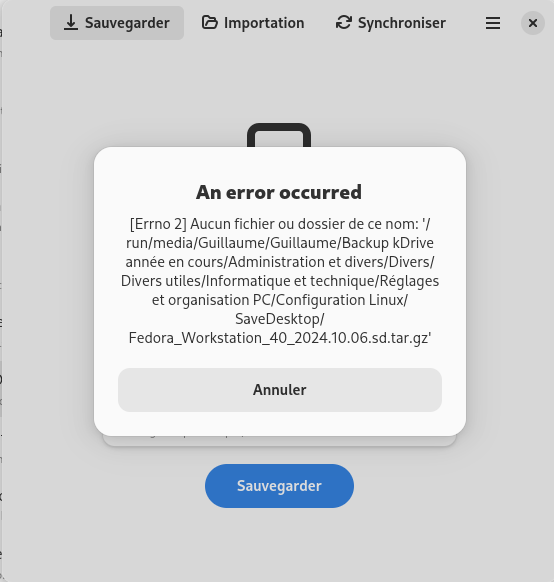Hi everyone,
I’ve been a happy user of Fedora Workstation since Fedora 36 on my Surface Go 1.
I really enjoy Gnome and everything is set up the way I want to.
Since I was really happy with my setup I just wanted to be able to replicate it easily through Clonezilla so that I could port it on any future computer I’d get.
Sadly, even with the help of really helpful and knowledgeable users on Lemmy, it hasn’t worked (https://sh.itjust.works/post/25963065).
So now I’m left wondering if there could be a distribution that I’d enjoy and which would be easy to deploy on another computer as I’d hate to have to configure everything on every computer I’d get.
I love Gnome but I wouldn’t be against trying something else if necessary.
What distribution could meet my needs?
I’d happily give technical advice but first I need to understand the actual need.
I don’t mean “what would be cool” but rather what’s the absolute minimum basic that would make a solution acceptable.
Why do I insist so much? Well because installing a distribution, e.g. Debian, takes less than 1h. Assuming you have a separate /home directory, there is no need to “copy” anything, only mounting correctly. If it is on another physical computer then the speed will depend on the your storage capacity and hardware (e.g. SSD vs HDD). Finally “configuring” each piece of software will take a certain amount of time, especially if you didn’t save the configuration (which should be the case).
Anyway, my point being that :
- installing the OS takes little time
- copying data across physical devices take a lot more time
- configuring manually specific software takes a bit of time
So, if you repeat the operation several times a week, investing time to find a solution can be useful. If you do this few times a year or less, it’s probably NOT actually efficient.
So, again, is this an intellectual endeavor, for the purpose of knowing what an "ideal’ scenario would be or is it a genuine need?
Well I don’t distro hop so I don’t think it would be used more than once a year.
The only thing is that I would want the way I’ve configured Gnome, Joplin, Thunderbird, Gnome Calendar (only for the widget), my Gnome extensions, what program is automatically opened on what workspace, etc to be saved so that it could be reproduced on another computer easily.
My documents, pictures, etc are already taken care of so it ain’t a problem.
I know I could do the same thing by writing a tutorial and just spending a couple of hours every time I reinstall. But I would want to just be able to replicate my install/settings if possible.
Someone kindly mentioned SaveDesktop and for now it seems like the way to go since simply cloning with Clonezilla doesn’t seem to work. I just have to make it work.
nixos
NixOS. A big learning curve but replicable.
++. Yes, and not your standard Linux distro in design, never mind the hurdle of understanding Nix expressions and functional programming language. However, once tweaked, deployment on multiple machines is straightforward.
replicable.
As someone who spent time in OS Build/Relmgmt before security, I have a pressing desire to play the “how do you know” game, here.
Because the only way to have a functioning NixOS system is to have it be reproducible. That’s the only way it works; Nix is reproducible by design.
The ability to reproduce a system implies the ability to replicate it.
NixOS is the sort answer. It’s reproducible across hardware. But I’ve never tested it.
For reproducibility, nothing really beats NixOS. That’s not really what you’re asking for, as that would not involve Clonezilla.
If you’re frequently switching hardware, and want to have everything up and running, configured to your liking, in minutes, you’re gonna have fun with NixOS in the long term. But I’m not gonna sugarcoat it, it has a steep learning curve and does require you to enjoy some tinkering. Worth it, imo
Otherwise, just pick a distro that you enjoy and create a separate home partition, when it’s time to switch you do a fresh install and clone only the home partition. That’ll get you 90% of the way to have your old setup on the new device
But what is a home partition?
I mean for me the problem is backing up my settings (including for every app) and I don’t know where they are saved.
Backing up my pictures, documents and others isn’t a problem.
Your settings for the most part are in your home directory, generally when you install a Linux system everything that isn’t the bootloader is on one partition (system, installed applications, etc)
Your home directory is for anything specific to your user, meaning your downloads folder, your pictures, documents and also your .config folder which holds 90% of the config files
There are some weird ones that have directories outside of home, afaik that’s stuff like network manager remembering your saved networks that runs outside of your user context
Usually your settings are saved under ~/.config
Cloning the system and home partitions always worked fine for me with openSUSE Tumbleweed with KDE Plasma desktop. Another option openSUSE offers is AutoYaST
AutoYaST is a system for unattended mass deployment of openSUSE Leap systems. It uses an AutoYaST profile that contains installation and configuration data.
NixOS is exactly what you want.
You declare your configs in a way that you can just copy them to another computer and it willbe configured the same way.
I’ve never tried it my self, but I might for my next machine.
I’d jump on the bandwagon of nixos, I use it myself and love it, does exactly what you’re asking for
However judging on some of your other comments it might be a better idea to just suck up having to manually rebuild until you understand the basics of Linux a little better
(nixos more or less requires you understand programming syntax for writing your system config)
(nixos more or less requires you understand programming syntax for writing your system config)
It’s technically not a real programming language but an expression language. The difference is that the former is a series of commands to execute in the specified order to produce arbitrary effects while the latter is a declaration of a set of data. You can think of it like writing a config file i.e. in JSON format.
The syntax isn’t really the hard part here. You can learn the basics that comprise 99% of Nix code in a few minutes.
The actually hard part is first figuring out what you even want to do and then second how the NixOS-specific interface for that thing is intended to be used. The former requires general Linux experience and the latter research and problem solving skills.It’s hard to say whether it’s difficult or not coming into it already knowing how to program
More people than not struggle to come to terms with what a variable is let alone all the stuff you can do in nix
There are definitely other hard parts, but I didn’t want to write a wall of text lol
I’m going to mention
Ansibleas I haven’t seen it mentioned, and it can be used to locally manage a reproducible builds.It has already been mentioned, but as a minimum to replicate your system you need two things:
- Transfer/copy your entire
/homedirectory as there is where the majority of the configuration files of your system pertaining the software you use (there could be configs you could need on/etcand on/usr/localor other dir), that is why it is recommended to partition your disk on installation of your distro, so the/homedirectory is already separated, as if you reinstall in the same machine you don’t lose any configuration in addition to your personal documents/pictures/etc - Have a way to automatically install a list of programs/apps/drivers/libraries, and that is what something like a bash script, Ansible, nixOs, etc. could help you with.
The truth is that using any of the tools in the second point requires learning a bunch, so if your skill level is still not there, there is some work to do to get there.
I’m going to mention Ansible
Oh for the love of god, don’t. Ansible is 2002 technology used in 2024. It’s so clunky and janky that I’m relieved I can get chatgpt to boilerplate my stuff and save me time actually staring at fucking YAML all day. Use Anything Else before your brain rots.
source: it’s like half my day job now and I should’ve charged more.
What would you recommend that is not NixOS or a Bash script and can be used agnostic of distro?
- Transfer/copy your entire
If you want something simple that does this for you: check out SaveDesktop. I’m not sure if it will meet every need, but it works for me when I need to switch.
Oh from reading what’s in the link, it looks like it’s exactly what I need.
I’ll go deeper into it.
Would you know why I’m getting that error? :

I’ve already allowed access to all system files through Flatseal.
I was not able to reproduce that bug, but I also did not change anything in flatseal, I think you shoulf just reset the permissions and/or reinstall and just try it normally.
I’ve managed to create an archive with SaveDesktop, but only on my internal disk drive as I think the external drive was what was creating the problem.
Do you know what would be the difference if I backup or don’t my home file? I’d have to find a way to back it up outside of home, but it’s complicated since it doesn’t work with an external drive.
I mean I don’t think I can backup home with Savedesktop inside home, so I’ll have to look at my file structure once I can get back in front of my computer.
I think the reason why it didn’t work on your external drive is that is a different permission to system files. Something to do with usb stuff.
When it comes to backing up your home files, I’m not sure what you mean by home file? Do you mean the home folder? Cause if so I don’t think SaveDesktop can do that as that includes all your files, not just your configs. You’d have to use another tool to move those folders.
Sorry as I’m struggling to express clearly.
SaveDesktop has the option to backup your home folder.
I was thinking that the save destination had to be outside of the home folder if I wanted to also backup my home folder. Otherwise it could end up in some kind of loop where the archive would contain itself and get bigger and bigger. That’s why I thought the SaveDesktop archive with the home folder shouldn’t be saved inside home.
I hope It nakes more sense 😅
I think it needs access to all your host files as well, let me see if I can replicate that error.
If you want to actually replicate one to one - any distro, and use dd or netcat to transfer the root partition. Reinstall the bootloader, update BLKIDs and you’re done. Worked for me multiple times.
So the question is this: Do you want to be able to reproduce the system exactly, or are you fine taking a few hours to reinstall software. If you’re just wanting to keep settings and data for apps rather than the apps themselves, you can cut down on your storage requirements a lot.
If it’s the latter, all of your user settings should be in your home directory (“/home/username” or just “~”). If you back that up, you should be able to recover your settings and data on a fresh install of your distro of choice.
Can you just make a base image and then clone the image across. You would need to change the machine ID but that’s pretty easy to do.
Alternatively you could use Ansible pull on a fresh install to set everything up
How can you just make a base image and change the machine ID?
I don’t know how clonezilla works, but one thing I’ve discovered that causes issues when you copy a Linux distro from one machine to another, assuming you do a file system copy and not a raw partition copy so the new file system partition has a different UUID than the old, you need to fix the UUID in both /etc/fstab and /etc/initramfs-tools/resume before it will work properly.
Clonezilla covers this, it regens the partition with the correct uuid.
My guess is some uefi or other boot weirdness, you have to register keys with the new system during install before it will let you boot, that’s probably where things went wrong.
you need to fix the UUID
Don’t use UUIDs. They serve a very specific purpose, which you’re now trying to defeat (for all the right reasons).
Fix your mounts and then carry on.
As a counterpoint to the majority of answers here, I’d love to suggest GNU Guix as the best answer. Like Nix, but enhanced for freedom with a formidable governance model. Built on freedom. Built to last forever. Also easier and more beautiful
How’s it’s hardware support GNU Trisequel was bad in that regard
it is built so that non-free packages can be made easily available (e.g. the non-guix channel). being sort of a meta-OS, already a bunch of operating systems were built on top of it, arguably easier to just get started as a novice
It is kinda painful and the repos are very slow
WDYM the repos are very slow?
i’m using it as a daily driver for a couple of years now









